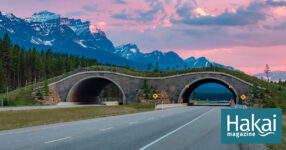
Do Marine Animals Need Wildlife Bridges, Too?
Article body copy
The ocean feels infinite. If you were to start swimming from shore, it’s easy to believe—fitness and oxygen aside—you could continue forever. That’s a far different experience to overland travel, where mountains, rivers, and six-lane highways buzzing with traffic thwart easy passage.
It’s equally easy to believe that fish and other highly mobile marine creatures experience the ocean in such an unrestrained fashion. These animals, adapted over millennia to navigate the ocean, must easily bypass any barrier around which they can theoretically swim. That assumption, though, is wrong.
According to Karissa Lear, an aquatic ecologist at Australia’s Murdoch University, it’s common for many marine species to stick to specific habitats and only seldom venture beyond them. That is especially true for many juvenile animals, she says, which are small and vulnerable to predation. This timidness can cause unexpectedly big problems for marine species, especially when infrastructure gets in the way.
Take, for example, the green sawfish living near the mouth of the Ashburton River in the Pilbara region of Western Australia.
In 2017, engineers working on a local oil and gas processing plant built a new loading facility consisting of a large piling jetty and solid rock wall, which stretched 500 meters offshore. At the time, Lear and her colleagues were concerned with how the construction would affect the critically endangered green sawfish, which uses the region as a nursery.
As time went on, however, the scientists realized that the green sawfish were unable, or unwilling, to pass around the barrier. That could prevent the animals from reaching valuable feeding grounds and other habitat. The juvenile green sawfish, says Lear, are probably too scared of getting nabbed by predators to leave the safety of their nearshore habitat to swim out and around the jetty. That, and they’re used to spending time in the shallowest waters.
To Lear, this discovery bolsters support for a surprising new idea: that marine animals, much like terrestrial species, need a helping hand getting around human infrastructure.
On land, wildlife crossings are becoming increasingly common. Green bridges, for instance, help bears and elk avoid a road in Alberta’s Banff National Park, while fish ladders help migrating salmon skip around dams. In 2022, a wildlife crossing in Washington State was used more than 5,000 times by animals such as mule deer, elk, and coyotes. Although they’re already popular in terrestrial ecosystems, Lear says little attention has been paid to the idea of wildlife crossings designed to help marine animals get around safely. In the case of the green sawfish, she says engineers could have created underpasses in the jetty through which the fish could swim.
But the real issue isn’t just one obstacle, says Lear: “If there’s barrier after barrier, you’re going to start having that juvenile habitat really constricted.”
For individual animals, too many barriers can cut them off from important feeding sites. At a population scale, overly restricted movement can lead to the development of isolated, genetically distinct groups that are more vulnerable to extinction. With at least four more large structures planned for the Ashburton River area, Lear says the cumulative effect of multiple barriers is a real concern for the green sawfish’s future.
As the climate continues to change, Matthias Goerres, the project coordinator of an ecosystem restoration project at the Association of German Nature Parks, says paying attention to the needs of marine animals is important. Many marine species are moving farther north because of climate change, he says, and they need suitable habitats to move through. For example, herring use seagrass meadows to breed, so stretches of seagrass farther north could help them migrate away from warming waters without affecting their natural behaviors.
Whether punching pass-throughs in artificial structures or plotting routes away from warming oceans, thoughtfully modifying our marine infrastructure could go a long way toward protecting animals as we continue to engineer the ocean.
Article footer and bottom matter
Cite this Article:
Cite this Article:
Jack McGovan “Do Marine Animals Need Wildlife Bridges, Too?,” Hakai Magazine, Sep 10, 2024, accessed September 12th, 2024, https://hakaimagazine.com/news/do-marine-animals-need-wildlife-bridges-too/.



